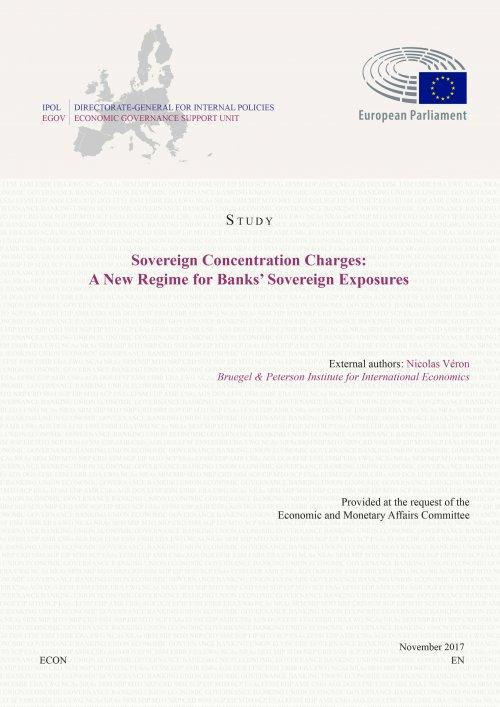Sovereign Concentration Charges are the Key to Completing Europe’s Banking Union
The past crisis revealed that most euro-area banks have disproportionate sovereign exposure in their home country. Charging banks for sovereign concen


This blog is based on an External publication that was originally published in a paper provided at the request of the Committee on Economic and Monetary Affairs of the European Parliament and commissioned by the Directorate-General for Internal Policies of the Union and supervised by its Economic Governance Support Unit (EGOV). The original paper is available on the European Parliament’s webpage
2018 is set to be a year of opportunity for fixing the flaws that the past decade of crisis has revealed in the euro area. Whereas the crisis is almost certainly over, memories are still fresh and complacency has not yet fully taken hold. The political timetable is propitious: France is energised with a new government, Germany will probably have one soon, and Italy too following the general election expected in March. After that, no major political upheaval is expected until the European parliamentary election in the spring of 2019, even though state elections in Bavaria around October will attract (and distract) some attention in Germany. The economic recovery is robust and broad-based. As European Commission President Jean-Claude Juncker put it, there is a favourable wind in Europe’s sails.
It is equally obvious, however, that reform will not be easy, and that not all shortcomings of the euro-area policy framework can be fixed next year. Leaders should not set their ambition impossibly high, and should focus on what is most essential. The driving engine of the euro-area crisis, as they acknowledged in successive communications from mid-2012 onwards, was the vicious circle between banks and sovereigns. Eliminating this core fragility must be the central objective of the post-crisis agenda. As at the climax of crisis in 2011-12, and using a simplified but apt analytical prism, this can be achieved through a fiscal union, or a banking union, or both. The preference revealed five years ago has been that, under Europe’s circumstances of incomplete political integration, a banking union is a more practical path than a fiscal union.
This preference remains relevant now. Euro-area reforms should aim at completing the still-fledgling banking union first and foremost, and specifically at dismantling national bank-sovereign linkages that remain very strong despite the (broadly successful) establishment of a Single Supervisory Mechanism and Single Resolution Mechanism in the past half-decade. The reforms should make it possible both that any future sovereign debt restructuring may not automatically trigger a banking panic, and that future large-scale banking crises may not automatically trigger sovereign debt distress.
Concentrated sovereign exposures are at the centre of bank-sovereign financial linkages. Most (though not all) euro-area banks have disproportionate sovereign exposure to their home country, for reasons that remain debated but have not been substantially eroded in the last few years of recovery. This “home-bias problem” is unique to the euro area, where banks can and should diversify their sovereign exposures away from their home country without incurring currency risk. Not only is it a key element of the vicious circle, the home-bias problem also deters progress on removing another major element, namely the fact that deposit insurance remains national. This is because some member states fear (not unreasonably) that an integrated European Deposit Insurance Scheme (EDIS), as proposed two years ago by the European Commission, could be abused by some sovereigns to secure preferential funding from “their” banks, in the absence of safeguards against such “financial repression”. Thus, achieving EDIS involves a broader policy package that includes addressing the home-bias problem.
As detailed in a study published last month by the European Parliament, this challenge can be met with a new regulatory regime that would disincentivise concentrated sovereign exposures. This mandatory (or in the jargon of the Basel framework for banking supervision, “Pillar-one”) instrument would consist of sovereign concentration charges, working as follows. In the current calculation of a bank’s risk-based capital ratio, the denominator is the bank’s total risk-weighted assets, an aggregate from which sovereign exposures (which are generally assigned a zero credit-risk weight) are almost entirely exempted. Under the proposed design, a second component would be added to that denominator, consisting of sovereign exposures weighted by coefficients (the concentration charges) that are set at zero for smaller exposures but increase with the exposure ratio (defined as the bank’s sovereign exposure to any given euro-area country, over its tier-one regulatory capital) above an “exemption threshold” set at 33% in the proposed calibration.
This rather simple design ensures that euro-area sovereign exposures are not charged for sovereign credit risk but only for concentration risk, echoing the specific nature of the euro-area’s home-bias problem (sovereign credit risk is a distinct and intrinsically treacherous issue, which is not particularly specific to the euro area and may in the future be addressed by the Basel Committee at the global level). Correspondingly, only euro-area sovereign exposures of euro-area banks would enter the calculation of sovereign concentration charges. Assuming banks respond to incentives, and eventually diversify their sovereign exposures within the euro area so that all come under the exemption threshold, this would not result in any competitive distortions that would put euro-area banks at a disadvantage to their peers, either in other EU countries or in the rest of the world. EDIS would be introduced in parallel with sovereign concentration charges, ensuring a proper balance of risk-sharing and market discipline.
This proposal builds on earlier suggestions made by regulators, and presumably also echoes recent non-public discussions in venues such as the EU Economic and Financial Committee’s 2016 high-level working group on the regulatory treatment of sovereign exposures, or the Basel Committee. It also goes further, by including specific proposals for calibration and transitional arrangements. The suggested calibration is adjusted so that exposures above 150-200% of a bank’s capital are effectively discouraged (so that the capital is not wiped out in a sovereign restructuring that can typically involve a haircut of up to 30-40%), while exposures under 50% are barely penalised (leaving ample space for activities such as market-making on sovereign debt markets, and avoiding forcing banks into diversification into too many countries). The following table summarises the calibration and its impact on capital ratios (itself dependent on the bank’s Tier-1 capital ratio, thus the two columns on the right; SCC stands for sovereign concentration charge; a basis point, or bp, is one-hundredth of a percentage point).
This impact would not be immediate, though. The study recommends a lengthy transition period, in which the sovereign concentration charges are phased in gradually, and moreover, any sovereign debt outstanding before the new legislation’s entry into force would be exempted from their calculation (or “grandfathered”). The combination of a mild calibration and cautious transition arrangements would ensure that this significant structural change can be introduced without causing any disruption in sovereign debt markets, and at a negligible cost to the banks themselves. Since EDIS also involves a long transition from the current national deposit insurance regimes, the two reforms could be decided together next year, and then unfold in parallel to reach a steady state in the late 2020s.
Sovereign concentration charges, combined with EDIS, would not be a panacea that cures all the euro area’s ills, but could decisively break the current deadlock in the discussion over banking union. For more fragile countries, the Europeanisation of deposit insurance, and the corresponding sharp reduction of the probability of a euro-area break-up (or “redenomination risk”), would vastly more than offset any negative impact of the loss of a specific role of domestic banks in smoothing the impact of sovereign debt market stress (a “shock-absorbing” role which, in any case, stands fundamentally at odds with the very principle of banking union). For countries with a lesser current perception of risk, the sovereign concentration charges would reassuringly bolster market discipline and ensure that EDIS is not subverted by a form of national financial repression. Furthermore, the removal of the current uncertainty over the future regulatory treatment of sovereign exposures would lift an obstacle to desirable cross-border banking consolidation. Every country would gain, as would the euro area as a whole.



